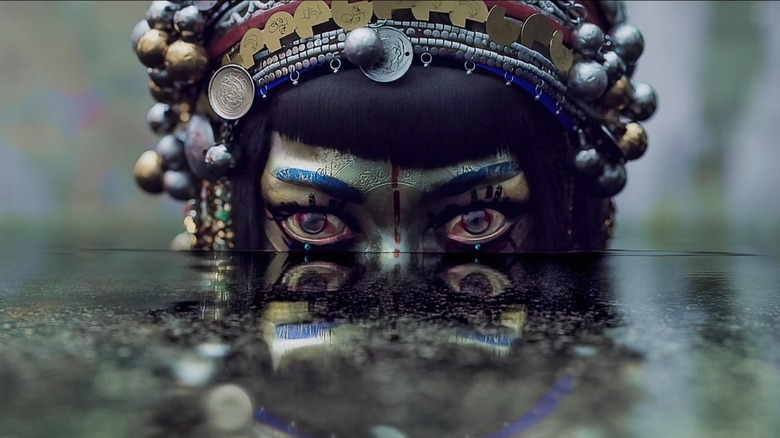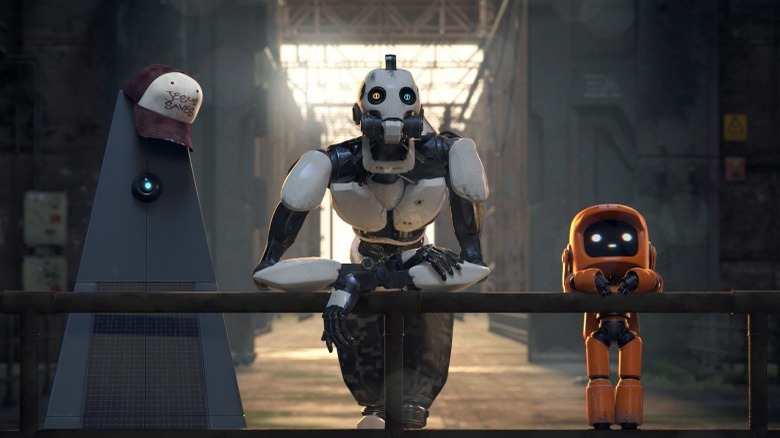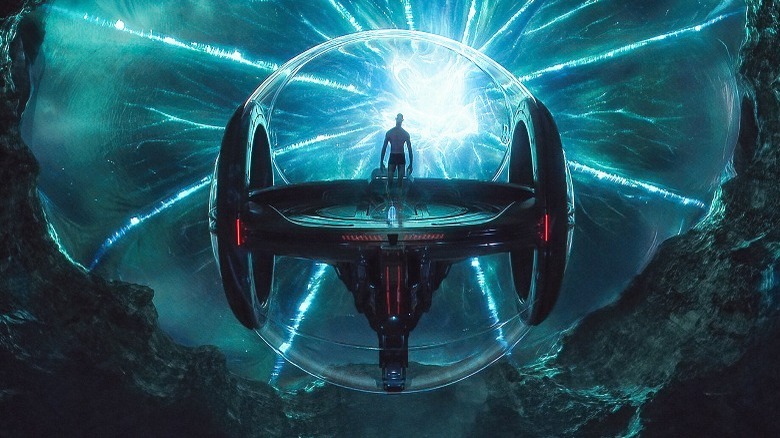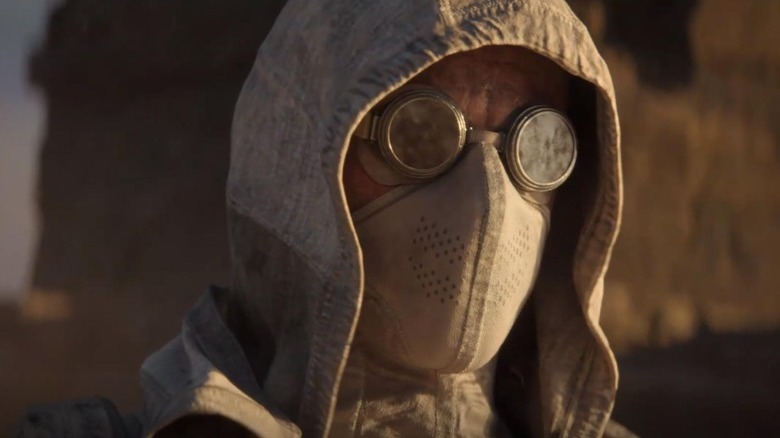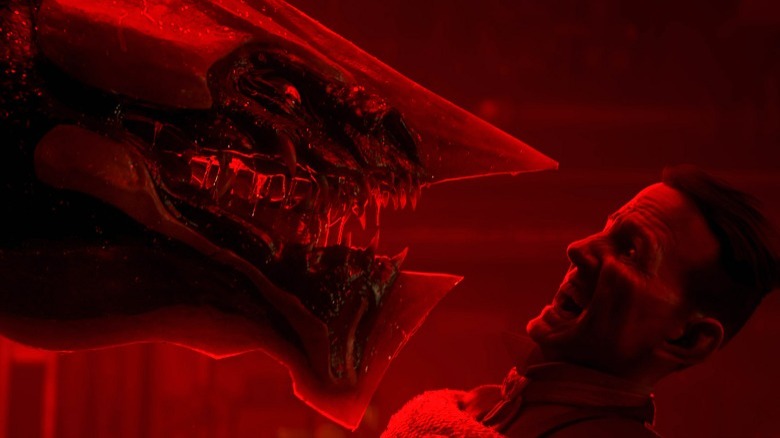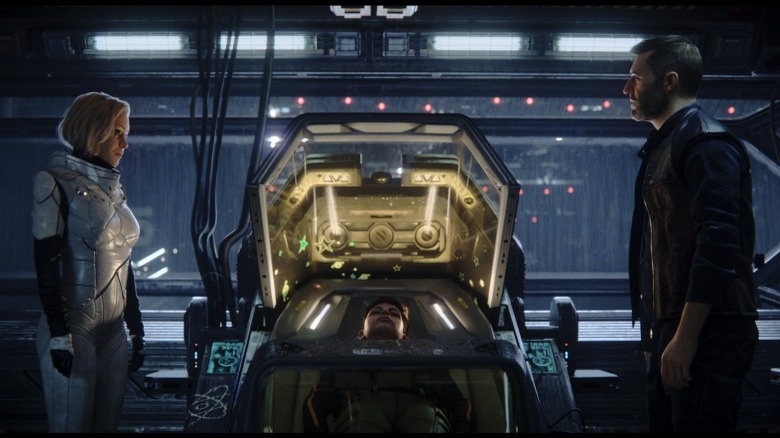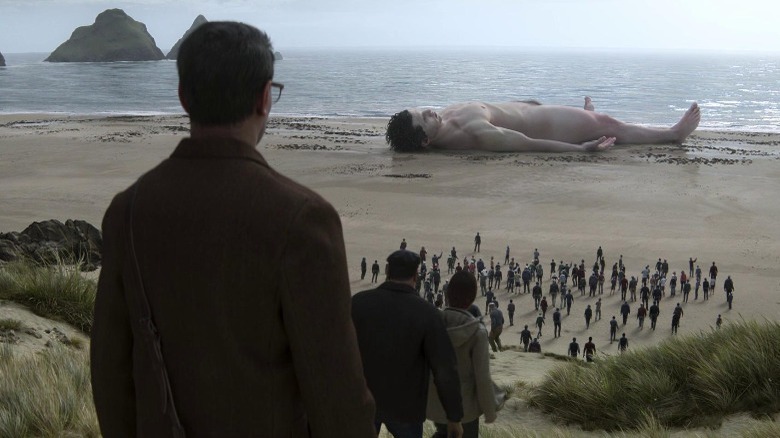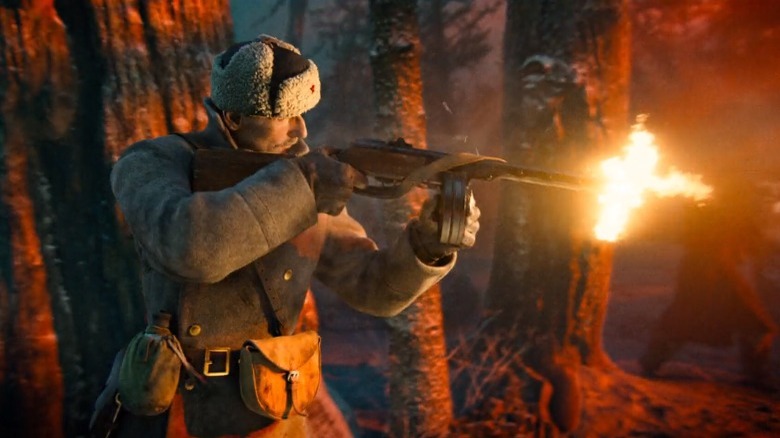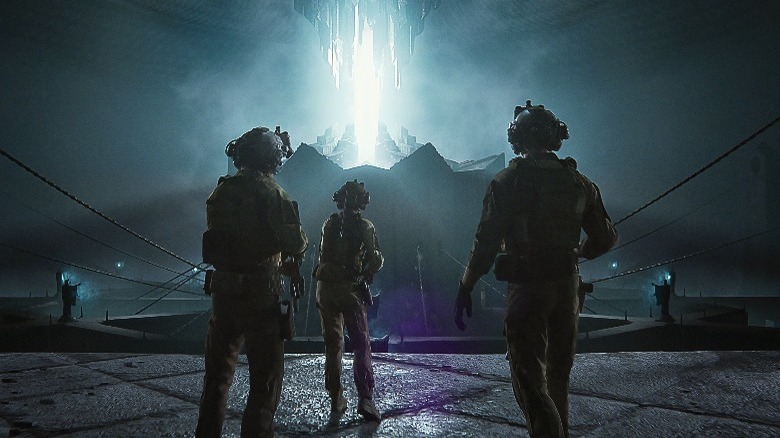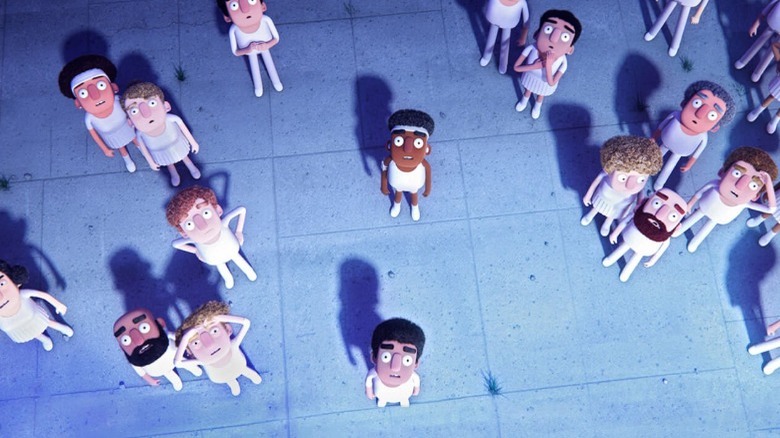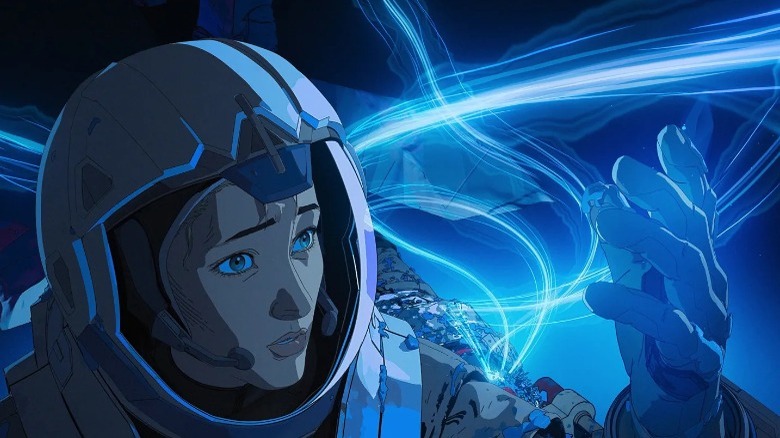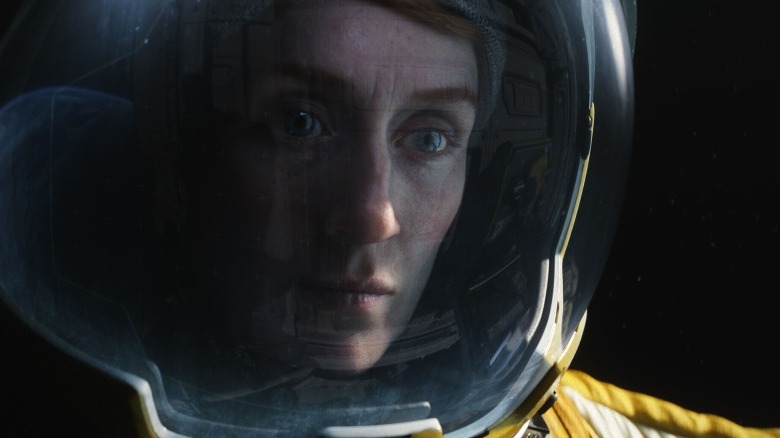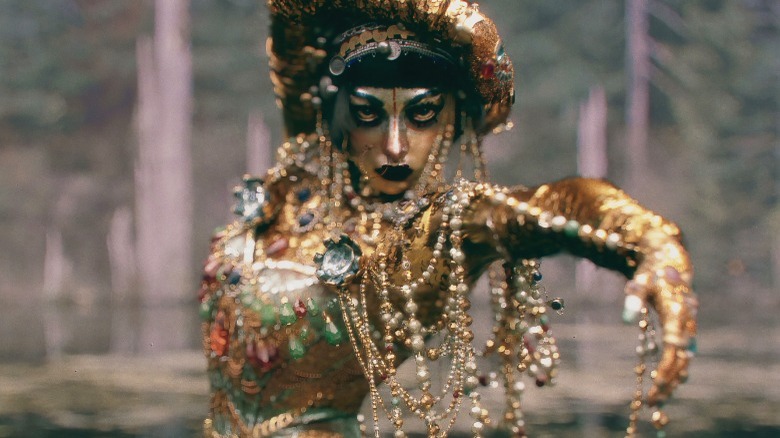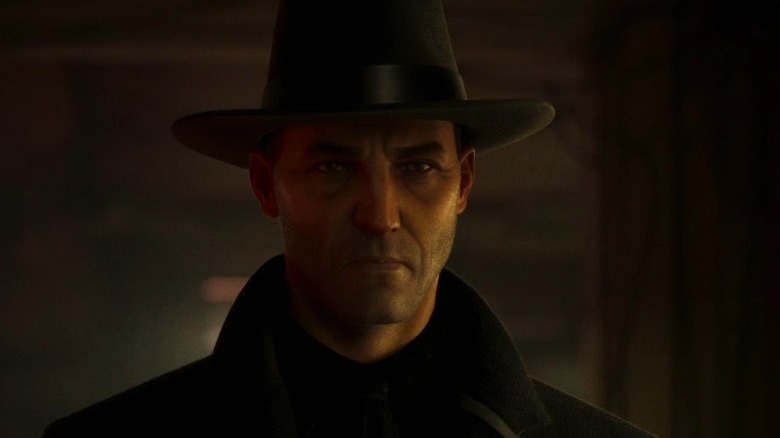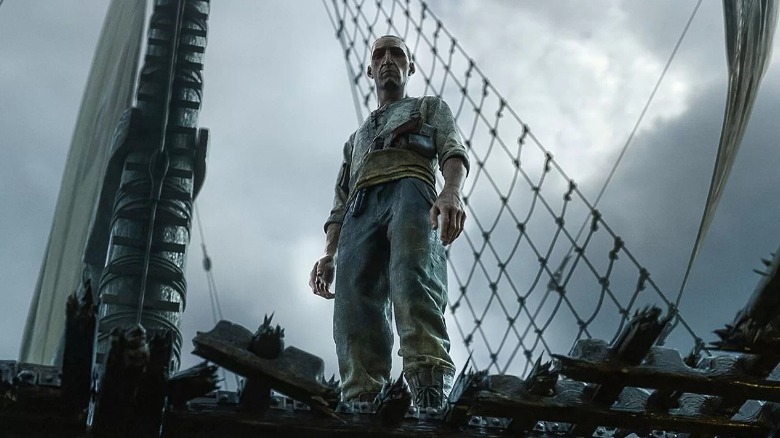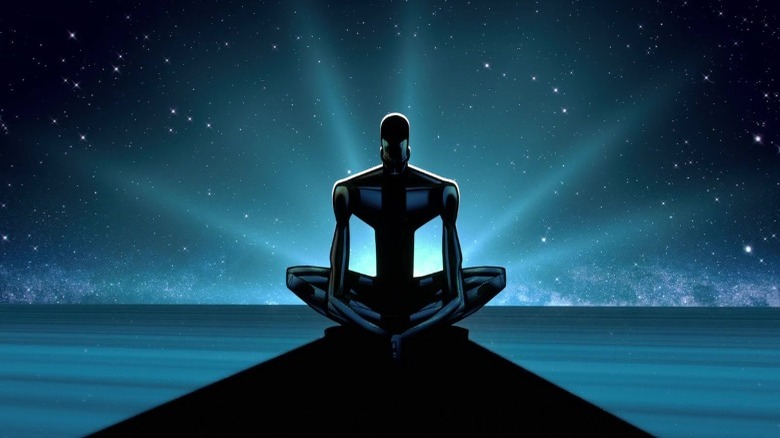The 15 Best Love, Death & Robots Episodes That You Need To Watch
More than any other anthology show, Netflix's "Love, Death & Robots" has polarized audiences. It may be hit or miss, but you can't deny that it's an eclectic, ambitious series that pushes the boundaries of animation, and its best episodes are some of the most interesting, vital genre work to come out of Netflix.
"Love, Death & Robots" veers between broad comedy, horrific body horror, and thought-provoking philosophical stories while simultaneously hopping between a variety of animation styles, ranging from artsy 2D productions to photorealistic CGI. The only common themes are the elements listed in the show's title — and even then, there are a few episodes that don't feature any of the three.
This series differs from anthology series like "Black Mirror" and "Inside No. 9" in that there's no general consensus on what constitutes the best episodes. With "Love, Death & Robots," every episode is so different that it's seemingly impossible to reach an agreement; what some viewers consider to be the strongest episode, others will dismiss as the worst. As such, this list is sure to rub some fans the wrong way. Of course, that's part of the fun of a ranking like this, so here we go!
15. Three Robots
One of the first episodes of the show, "Three Robots" showed that "Love, Death & Robots" could do comedy just as well as horror. It's adapted from a short story by John Scalzi, and while the source material has an unwieldy title — "Three Robots Experience Objects Left Behind from the Era of Humans for the First Time" — it sums up the plot pretty concisely!
It's a simple short, but one that allows for a lot of fun dialogue as the titular three robots explore the ruins of planet Earth and try to piece together exactly what wiped out the human race. That premise that could get stale very quickly, but the episode manages to stay fresh thanks to the interplay between the three characters, all of whom are immediately identifiable archetypes: the perennially enthusiastic K-VRC (Josh Brener), the bemused XBOT 4000 (Gary Anthony Williams) and the dryly sarcastic 11-45-G (voiced by a text-to-speech program).
The story might seem a little inconsequential, but the small details that inform the characters are expertly done, and the jokes at the expense of humanity are playfully on-point; a witty final rug pull wraps the episode up nicely.
14. Swarm
Human arrogance and intellectual hubris are common downfalls in "Love, Death & Robots," as demonstrated by this tale of scientists underestimating a seemingly unthinking alien species.
The Swarm is an alien ecosystem that sustains itself through naturally subservient drone creatures who perform their functions without question; the kindly Dr. Mirni (Rosario Dawson) describes it as "primordially innocent." The newly arrived Dr. Afriel (Jason George) plans to harness this workforce to service humanity, effectively turning it into slave labor. So, he recruits the reluctant Mirni, who has already been accepted by the aliens, for his cause. As you might expect, things don't go according to plan. Afriel's scheme triggers a genetic response from the Swarm, and the ecosystem turns the tables on the arrogant scientists.
"Swarm" is an episode with big ideas, and it largely pulls them off, featuring beautiful visuals, a wonderfully detailed alien environment, and some unique creature designs. It also contains one of the series' most grimly horrific moments, as the Swarm goes to gruesome extremes to defend itself from humanity.
13. Snow in the Desert
Season 2 is probably the least successful installment of "Love, Death & Robots." At only eight episodes long, it doesn't have much time to make an impression, and while many of the episodes are fun, it feels less substantial overall than those seasons on either side of it.
"Snow in the Desert," a conventional fable that resembles a western in space, might be the most complete story of 2021's batch of episodes. Snow is an enhanced human who has the ability to regrow his limbs, making him basically immortal. He's also being hunted by fellow bounty hunters to a remote desert planet. When Snow is ambushed by a gang of mercenaries, he loses his arm and is rescued by the mysterious Hirald, who is inextricably drawn to him.
It's all very straight-faced, and aside from an interesting rumination on the practicalities of immortality, the story is fairly standard, but this episode is more about stunning aesthetics than plot. The animation in "Snow in the Desert" is incredibly detailed, making impressive use of lighting and composition. It's also one of the very few episodes to close with an honest-to-God happy ending; the final image is particularly touching.
12. Sonnie's Edge
Leaving aside the grating British accents, the very first episode of "Love, Death & Robots" sets the series' fatalistic, twisted tone quite nicely, and the concept of warring monsters controlled via telepathic links is established quickly and efficiently.
The setting for this story is an underground fighting arena that's something like an R-rated version of the robot fights from "Big Hero 6." The Sonnie of the title arrives for a big fight, unswayed by the prospect that the match might be rigged by the local crime lord, who is intent on learning how Sonnie keeps winning.
With the aforementioned dodgy accents, some very hammy dialogue, and a hint of the problematic gender politics that plague the show's first season — there's an overreliance on women's trauma, and a hyper-sexualisation that often reduces the female characters to commodities — "Sonnie's Edge" isn't the most impressive episode of "Love, Death & Robots." However, at its core it's an excellent distillation of the primary themes that the series is concerned with, and it more than lives up to the show's title. Oh, and the animation, especially during the vicious fight sequences, still stands alongside the series' very best.
11. Beyond the Aquila Rift
The most harrowing episode of the first season, "Beyond the Aquila Rift" is a deceptively simple story that relies on a devastating twist. Thom is the captain of a spaceship that has drifted off course on its journey back to Earth; waking up from cryo-sleep, he is greeted by his old flame, Greta, who arrives as part of a rescue team. As Thom attempts to revive the crew and reignite his relationship with Greta, he begins to question the true nature of his new surroundings, leading to a truly disturbing conclusion.
Based on a short story by Alastair Reynolds, who also provided the material on which the incredible "Zima Blue" is based, this adaptation streamlines the plot without sacrificing the horror of the ending. The sex scene here is graphic but not gratuitous — it informs the mysterious Greta's motivations, and makes the final reveal all the more disturbing.
The ending isn't massively surprising, but it differs from similar twists in its overall ambiguity. It's left up in the air as to whether we should accept Greta's claim that she means well, or if the forces at play are more malevolent. Going by the conflicted look on Greta's face in her final close-up, I'm inclined to take the former view.
10. The Drowned Giant
Potentially the strangest episode of the entire series, and with a much richer literary pedigree than most (it's adapted from a short story by J.G. Ballard), "The Drowned Giant" features no love, no robots, and only one death, and yet still retains the uncanny, eerie feel of the show's very best episodes.
The first effort from series co-creator Tim Miller, "The Drowned Giant" is an altogether quieter, more contemplative story, one that's more concerned with the fragility of the physical self and the morbidity of humans as a group. When the body of a giant washes up on a British beach, a scientist becomes quietly obsessed with the corpse's gradual decomposition and the impact it has on the local community. The crowds of people who are drawn to the beach are initially enthralled by the sheer spectacle of the giant's body, only to gradually subject it to numerous indignities, eventually turning it into something to be defaced, chopped up, and sold.
The short film is incredibly faithful to Ballard's story, with much of the narration taken verbatim from the source material. The overall tone is more melancholy than macabre, although it remains just as much of an indictment of humanity's callous nature as the show's more overtly satirical episodes. "The Drowned Giant" is an elegiac, sadly plausible rumination on human apathy, and a nicely judged change of pace for the series.
9. The Secret War
While "The Secret War" has a fairly conventional setup — a platoon of Russian soldiers is dispatched to snowy Siberia to hunt down flesh-eating demons — this episode is elevated by the slick execution of its story. It's all killer, no filler as the soldiers resolve to track the demons to the gateway to Hell and close it for good.
The animation in "The Secret War" may resemble a video game cutscene in places, but the characters are all sketched out quickly and vividly, and we immediately understand who they all are. The narrative is pretty straightforward, but the details are revealed sparingly, with an economical script that efficiently doles out information.
As it becomes clear there is no hope for the platoon, the soldiers prepare to fight to the last man. Their final stand is suitably epic, complete with a rousing speech from the commanding officer, a poignant little reveal, and an incredible score blaring over the action. It's a gloriously edited, operatic climax, one that's followed by a muted epilogue in which a balalaika mournfully plays over the aftermath of the battle, ending the episode on a quiet, melancholy note.
"The Secret War" might be a simple story, but it's one that's told really well, with some incredible visuals and strong character work. It's one of the most purely entertaining stories of the entire run.
8. In Vaulted Halls Entombed
"In Vaulted Halls Entombed" is about the most faithful translation of H.P. Lovecraft's work ever committed to the screen, and it's not even a direct adaptation. It takes cues from "The Call of Cthulhu," but is set in the modern day, and features lashings of unpleasant gore that you wouldn't find in Lovecraft's writing. A unit of American soldiers chase down a hostage who has been kidnapped by an Islamist cell, tracking them to a hidden cave. As they venture inside, they are confronted by flesh-eating spiders — and worse — forcing them deep into the bowels of the mountain, where they encounter an ancient evil that's just waiting to be unleashed.
The visuals are incredibly lifelike, making the characters' nightmarish fates all the more horrific, and there is some wonderfully evocative lighting that's reminiscent of the work of Guillermo Del Toro or Ridley Scott. It's all incredibly atmospheric, especially the gargantuan prison cell at the bottom of the cave, with towering pillars, enormous chains, and nightmarish statues that dwarf the surviving soldiers. It's incredibly creepy, and adds a palpable sense of dread to the story.
"In Vaulted Halls Entombed" also has an unnervingly ambiguous ending. The echoing whispers of the eldritch horror and the unhinged mutterings of the sole survivor are chilling, and linger in the memory long after the episode has ended.
7. When the Yogurt Took Over
As if to prove that "Love, Death & Robots" is not all grim and broody, "When the Yogurt Took Over" is a funnier and more irreverent episode, full of puns and a playful cynicism that recalls Douglas Adams' "The Hitchhiker's Guide to the Galaxy".
With Maurice LaMarche and his wonderfully sonorous voice bringing the omniscient narrator to life, this episode serves as a very different kind of invasion story. A sentient yogurt surreptitiously takes over the planet by making itself indispensable to the human population. The yogurt solves fusion within minutes, demands the whole of Ohio as a base of operations in exchange, and quickly demonstrates an unnerving understanding of human nature.
At only 6 minutes long, "When the Yogurt Took Over" is the shortest episode of the entire series. While we wish there was more, it still manages to contain more thought-provoking ideas than many of the longer episodes. It uses the whimsical tone and childlike animation to sneak some very subversive ideas by the viewer (one moment involving starving citizens preparing to eat a baby is punctuated by some neat cross-cutting), making the episode ultimately pretty disquieting, if not quite as substantial as some of the show's more serious episodes.
6. The Very Pulse of the Machine
Only "Love, Death & Robots" could contrast the terror of being isolated on a desolate planet with the William Wordsworth poem "She Was a Phantom of Delight." This entry from season 3 has the profundity and lyricism of the show's very best episodes, with the most striking animation of the entire series, a beautiful mix of 2D animation and a trippy homage to French cartoonist Moebius.
The story follows an astronaut, Kivelson (Mackenzie Davis), who becomes marooned on Io, the largest moon of Jupiter, after crashing her spacecraft and killing her co-pilot, Burton (Holly Jade). As she makes her way to the rendezvous point, Kivelson must use Burton's oxygen supply and inject herself with pain medications to keep herself alive. But are the psychedelic visions she encounters merely side effects from the drugs, or is the moon really trying to telepathically communicate with her?
"The Very Pulse of the Machine" is one of the series' more cerebral episodes. The ending is presented as an ultimately transcendental experience for Kivelson, but it can just as easily be read as a subtly ominous conclusion, as her voice calls in a rescue team to presumably meet the same fate that she does. It's an eerie final moment masked as something uplifting.
5. Helping Hand
Essentially a condensed version "Gravity" but altogether more visceral, "Helping Hand" follows solo astronaut Alexandria Stevens (Elly Condon) as she performs routine repairs on her spacecraft, only to be cast adrift in space with a rapidly depleting oxygen supply and nothing to help her get back to her ship other than her spacesuit. In this nightmarish situation, she proves resourceful in the most gruesome way possible.
Stevens is a grimly determined character, and the yawning expanse of space is hauntingly realized; the episode serves as a supremely tense demonstration of the strength of human will in the face of oblivion, and the extremes that we will go to in order to survive. The photorealistic animation makes Stevens' grisly solution all the more unpleasant to watch, with every detail rendered perfectly. "Helping Hand" is a tense and suspenseful story — the use of physics in the vacuum of space has never been as gripping, shocking, or bone-crunchingly nasty as this.
4. Jibaro
Season 1's "The Witness," directed by Alberto Mielgo, is a beautifully animated episode with a killer twist, but it's also emblematic of one of the series' most pervasive problems — at Digital Spy, Abby Robinson calls it "yet another display of female suffering and degradation for the sole purpose of entertainment."
Mielgo's second effort, "Jibaro," is similarly violent and uncomfortable, but it tells a more mature story, a beautiful dance of death that contains some eerily choreographed fight sequences that were somehow made without motion capture. Instead, the animators studied dancers obsessively to produce the main antagonist's dizzying movements. This frenzied style fits the story perfectly, as a battalion of conquistadors are inextricably drawn to their deaths by a forest siren. A deaf soldier is spared this fate, but finds himself unable to escape the siren anyway.
The overall meaning of "Jibaro" is left open to interpretation, but there are clear overtones of sexual assault in the way the soldier rips the jewels off the siren's body. It's brutal and deeply uncomfortable — it's no coincidence that he's a conquistador, as those soldiers were infamous for plundering and raping in their hunt for riches. The siren herself is beautifully rendered, and her call is curious in that the piercing scream she emits is jarring and abrasive, not entrancing like you might expect. "Jibaro" is an audacious assault on the senses, and while often difficult to watch, it sears itself into your memory like no other episode of "Love, Death & Robots."
3. Pop Squad
"Pop Squad" is clearly influenced by "Blade Runner" in its depiction of a dystopian future where advances in technology have eliminated natural death altogether, leaving people reliant on rejuvenation procedures to keep themselves young. As a byproduct, a ban on reproduction keeps the population in check, leading to the formation of the Pop Squad, law enforcers tasked with hunting down and killing illegal children.
That's a morbid, fatalistic premise that presents the human race at its most selfish and narcissistic, and the episode never shies away from this world's grim reality. The scenes in which children are killed are incredibly shocking (especially given the episode's cutesy animation style) and the toll it takes on the dour protagonist, Briggs, is evident from his very first appearance. Following a hunch, Briggs tracks down an illegal mother and her child, but rather than terminate them, he sits down and tries to understand why anyone would put aside immortality and risk imprisonment or execution to raise a kid.
"Pop Squad" is the stand out episode of season 2, with animation that shifts from subtly nuanced to epic in scale. While it's not as nasty as the Paolo Bacigalupi short story it's based on, it perfectly captures the tale's downbeat tone, and effectively conveys the sacrifice humanity has made in order to survive.
2. Bad Travelling
David Fincher's animated directorial debut is one of the very best stories "Love, Death & Robots" has to offer. His framing and use of light is incredibly cinematic, and there is a real economy to the script that translates well to the screen; Fincher allows the visuals to speak for themselves, rather than spelling everything out for the audience.
Set on an alien planet where sea monsters roam the oceans, "Bad Travelling" follows a ship that falls victim to a Thanopod, a gigantic crab-like creature that decimates the crew before taking up residence in the vessel's hull. Torrin, the resourceful first mate, is selected to face the creature, who demands to be taken to the nearby Phaeden Island, where it can feed on the local population (in a gruesome touch, the monster communicates using a dead crewmember as a kind of glove puppet). Torrin quickly turns the tables on the unscrupulous crew and uses his new position to his advantage, attempting to thwart the Thanopod's plans, although his crew has different ideas.
The characterization is reminiscent of "The Secret War" in that the crew is populated by well-worn archetypes who are immediately recognizable — each character is just memorable enough to keep track of. Torrin himself is a great protagonist, cunning and ruthless while possessing a clear moral compass, managing to out-think the brawnier crewmembers and the monster alike. From the visuals to the characters, "Bad Travelling" is a perfectly executed story, and the result is one of the most wholly satisfying episodes of the show's entire run.
1. Zima Blue
"Zima Blue" doesn't feature any nudity or violence; the 2D animation, while striking, isn't particularly revolutionary. It doesn't matter. This episode is a beautiful piece of art, and transcends the show's format to become the most moving, intellectual, and heartfelt episode of the entire series.
Part satire of the art world, part philosophical parable, "Zima Blue" tells the story of an enigmatic, universally lauded artist who creates towering landscapes, all of which use a distinct shade of blue. When he's profiled for a magazine article, a journalist uncovers the truth about his meteoric rise, and the basis for his final masterpiece.
The episode is a meditation on artistic fulfillment and the universal pull to return to what we know, as Zima achieves happiness by reverting to his childhood. The stylized, angular designs are initially off-putting, but quickly take on a scale that is vivid and eye-catching, while Zima's landscapes are both beautifully rendered and plausible representations of modern art in their own right.
While some installments of "Love, Death & Robots" feel lightweight given their brief runtimes (hey there, "Fish Night"), "Zima Blue" unfolds at a meditative pace, bursting with pathos and weighty philosophical ideas despite being only 10 minutes long. The final sequence is simultaneously moving and thought-provoking, with Zima's final line, "I'm going home," concluding the episode on a bittersweet, quietly moving note. "Zima Blue" remains the most singular episode of "Love, Death & Robots" and a perfect encapsulation of what the series could accomplish if it steered away from the sex and violence of its more sensational episodes. It has yet to be bettered.
